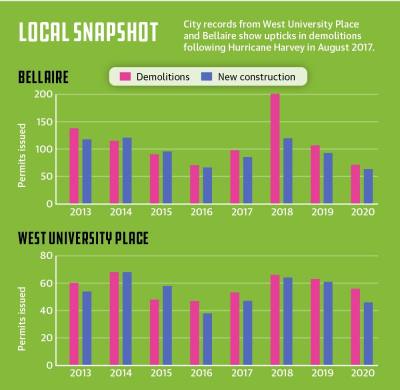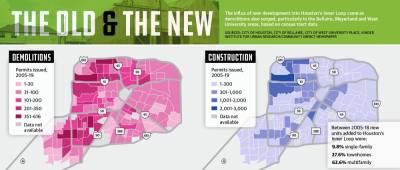Redevelopment trends across Houston over that time saw single-family homes largely being replaced with multifamily and townhome projects in many neighborhoods.
Over the course of the study’s timeframe, 9.8% of new units added in Houston’s Inner Loop was single-family housing, while townhomes and multifamily units made up the remaining 90.2%.
This is a stark contrast to cities inside the Loop such as Bellaire and West University Place, where new construction has continued to bring detached single-family homes to the area, which officials in both cities said is due in large part to zoning regulations.
However, the markets in these two cities offer their own trends, and demand for land is at an all-time high. As president of the Bellaire Historical Society, R.W. McKinney—who often goes by “Mister McKinney”—is in the middle of a historical home survey in the city. He estimates between 10%-20% of the original homes built between the 1910s and 1930s remain.
“I’ve noticed a trend in the last 25 years, where homes are just being demolished nonstop,” he said.
A closer look
To more closely analyze housing data in Harris County, the Kinder Institute report subdivided the county into three geographical areas across the three major concentric highways that encircle Houston: inside Loop 610, between Loop 610, and Beltway 8, and beyond Beltway 8.
Across these three areas, the report compares newly built units as well as the number of construction and demolition permits, among a plethora of other data.
The Inner Loop saw nearly 7,300 single-family detached homes built between 2005-18, representing 3.6% of the single-family homes built during those years. About 162,000 were built in that time frame beyond Beltway 8.
While the Inner Loop had the fewest construction permits issued out of the three geographic areas, it had the highest demolition activity.
For both Bellaire and West University Place, demolition and construction permit activity remain consistent.
West University Place, for instance, approved 484 demolition permits between the start of 2013 and June 2021, and 460 single-family residential construction permits. In that time, activity never dipped below 38 approved construction permits and 47 demolition permits in any given year—both of which were seen in 2016.
Due to city zoning ordinances, housing size has also remained consistent. Homes can only be constructed at up to 80% of a lot’s framed area, a measurement that includes the second floor, garage, and more.
“We limit the size of the home based on the square footage of the lot,” said Clay Chew, West University Place building official. “So if you have a 5,000-square-foot lot, you’re limited to 4,000 square feet of framed area.”
By comparison, the city of Houston does not have zoning and instead governs development through ordinance codes that address how property can be subdivided, but do not address land use, according to the city’s charter.
Meanwhile, Bellaire maintains similar residential zoning districts to West University Place by restricting single-family residential structures to one of four districts based on the dimensions of the lot.
“So if a person came to you and they said they wanted to have a home of X amount of square footage, then you would know, potentially, where that would fit,” Bellaire’s Director of Development Services ChaVonne Sampson said.
Bellaire has approved 926 demolition permits and 789 construction permits since 2013, according to permit data released by the city.
Side effects
Families looking for a small-town feel inside the city of Houston have been flocking to the cities of Bellaire and West University Place, according to local Realtors.
Clayton Katz, a Compass Real Estate agent who grew up in Southside Place, said he grew up observing the family-rst atmosphere offered by West University Place.
“That’s what drives the strength of the market,” he said. “It’s the kind of neighborhood where you actually know your neighbors. That’s pretty rare, especially in the price point West U has hit.”
The demand for homes in West University Place has grown to the point that those on the market end up facing bidding wars among potential buyers, pushing up the price, said Jan Pappert, a Realtor who sells homes in West University Place and other Inner Loop communities such as Bellaire.
According to the Houston Association of Realtors, the price per square foot in West University Place was $379 in 2020, down from an all-time high of $423 per square foot in 2018. This compares to the Meyerland neighborhood, which saw a price per square foot of $152 in 2020, according to HAR.
When the land becomes more important than the structure that the property is sitting on, demolition and rebuilding become more commonplace, Katz said.
“If you have a 1970s or 1980s home, and the land supersedes it, it makes more sense to tear the house down as far as when you look at the math of getting value, or getting a spec house built, versus a renovation,” he said.
Similarly, Bellaire has also faced price increases. From 2013-16, the price per square foot for a home in Bellaire increased from $230 to $261, though that price has since fallen to about $251 per square foot in 2020, according to HAR data.
This comes amid a building supply shortage that saw the price of lumber hit $1,667 per 1,000 board feet on May 7 before leveling o in June, according to Trading Economics, which provides historical data and economic forecasts.
“We could go on so many tangents because new construction is so expensive now, and people don’t want to wait,” Pappert said about building in Bellaire. “So they’re paying more for an existing home and spending more and updating them.”
Meanwhile, the trend of demolishing old homes and building new homes has had more of an effect in Bellaire than just a financial one, McKinney said. Because of the widespread redevelopment, he said he believes Bellaire has lost touch with its farming town roots.
“The city is having an identity crisis,” he said. “It doesn’t know what it’s been probably since the late ’90s because there’s an infusion of too much.”








